Objects : 132
-
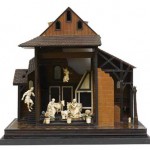 ObjectBonaparte Family Nativity Scene
ObjectBonaparte Family Nativity SceneAlthough this is an object of religious devotion, it is also a true work of art. With its finely executed ivory figures, its ebony and mahogany decoration, and its elaborate composition, the Bonaparte family’s nativity scene is one of the Musée Nationale de la Maison Bonaparte’s most fascinating pieces. The exceptional quality of the scene’s […]
-
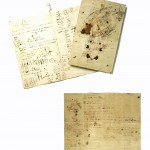 ObjectNapoleon’s English Lessons
ObjectNapoleon’s English LessonsThese eight pages of writing, covered in the impatient scribbles of a man determined to learn the language of his captors, are some of the most evocative documents we have from Napoleon’s time on Saint Helena. His arrival on the British outpost in October 1815 heralded an exile that was not only geographic, but also […]
-
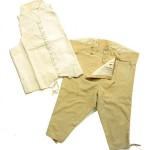 ObjectWaistcoat and Trousers worn by Napoleon on St Helena
ObjectWaistcoat and Trousers worn by Napoleon on St HelenaWaistcoat Technique: “Piqué” Dimensions: 62 cm long, 114 cm around the chest Trousers Technique: Casimire, a thin cotton or linen twill Dimensions: 79 cm long, 110 cm around the waist These trousers, called a culotte de casimir in French, are made of casimire, a thin cotton or linen twill, and are absolutely typical of the […]
-
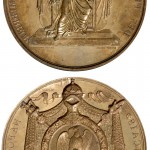 ObjectMatrices of the Seal and Counter-Seal of His Majesty Napoleon I (1805)
ObjectMatrices of the Seal and Counter-Seal of His Majesty Napoleon I (1805)The matrices of the Imperial Seal (consisting of a seal and a counter-seal) were made in 1805 by the engraver Nicolas-Guy-Antoine Brenet ( 1770-1846 ) and edited by Vivant Denon (1747-1826), Director of the Musée Napoléon. The Law on the State Seal was promulgated on 16 Pluviôse XIII (5 February 1805): “Article 1. The state […]
-
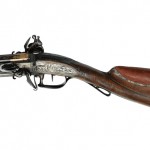 ObjectNapoleon I’s hunting gun
ObjectNapoleon I’s hunting gunSigned Le Page à Paris – Arquebusier de l’Empereur Engraved inscription “Ile d’Aix le 15 juillet à 8 heures du soir, 1815” Inv. 1111 , donation Lapeyre This large hunting gun was presented by Napoléon to Captain Besson on 14 July 1815 as a final gift of thanks for having organised an escape attempt to America. […]
-
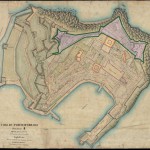 ObjectCadastral map of Portoferraio, Elba
ObjectCadastral map of Portoferraio, ElbaThis cadastral map of Portoferraio (entitled COM: DI PORTOFERRAJO, Sezione A, detta della città Foglio Unico) comes from the extremely important corpus of 19th-century cadastral maps created before the great urban transformations which occurred in Tuscany at the end of the nineteenth century. Indeed, this corpus is of fundamental importance for the reconstitution of the […]
-
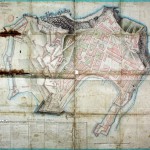 ObjectFortifications, Island of Elba. Plan of Portoferraio, An 10,
ObjectFortifications, Island of Elba. Plan of Portoferraio, An 10,This plan of Portoferraio (entitled “Fortifications, Isle d’Elbe. Plan de porto ferrajo, an. 10”), made in 1802 by Baron Charles Humbert Marie Vincent, first Director of Fortifications on the island of Elba, shows all the military buildings in the city, noting those related to Forte Stella and those connected to Forte Falcone, giving also the […]
-
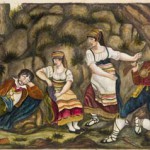 ObjectMemoirs, Journeys and Campaigns in Europe, from Egypt to the Disaster at Waterloo
ObjectMemoirs, Journeys and Campaigns in Europe, from Egypt to the Disaster at WaterlooThis manuscript of 4 volumes of nearly a thousand pages written by the soldier Chevalier is a lifetime’s work. The author debuted editing it in 1830 and during nearly twenty years he ordered notes he had accumulated in the course of his career and illustrated himself. He tells us in his introduction that he is writing his […]
-
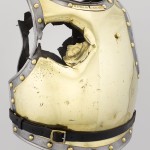 ObjectCarabinier’s Breastplate from the Waterloo Battlefield
ObjectCarabinier’s Breastplate from the Waterloo Battlefield“It was a poignant sensation, standing in the nocturnal silence and gazing on the battlefield, which during the day had been a theatre of fighting and now was so calm and silent, the actors spread on the bloodied soil, their pallid faces turned to the cold rays of the moon which reflected off the helmets […]
-
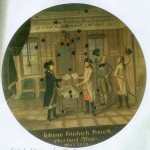 ObjectPainted Target depicting the Preliminaries of the Peace negotiations concluded at Leoben in Styria, 18 April 1797.
ObjectPainted Target depicting the Preliminaries of the Peace negotiations concluded at Leoben in Styria, 18 April 1797.The development of shooting societies in central Europe from the end of the 18th century saw the creation of painted targets destined for sporting competitions. Recently brought to light by the exhibition The Target: Croatian Painted Targets and Contemporary Art (Musée de la Chasse et de la Nature, 20 December 2012 -21 March 2013), this […]

